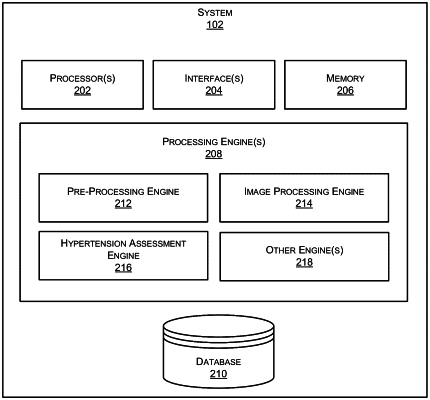| CPC A61B 5/7275 (2013.01) [A61B 5/015 (2013.01); A61B 5/02141 (2013.01); A61B 5/0261 (2013.01); A61B 5/7264 (2013.01); G06T 7/0012 (2013.01); G06T 7/174 (2017.01); A61B 5/02007 (2013.01); G06T 2207/30104 (2013.01)] | 17 Claims |

|
1. A system for measuring a hypertension condition of a subject, the system comprising:
a set of thermal sensors for capturing one or more of thermal images and/or one or more of thermal videos of at least one body part of the subject; and
a processing engine operatively coupled to the set of thermal sensors, and comprising one or more processors coupled to a memory, the memory storing a set of instructions executable by the one or more processors to:
receive a set of data packets associated with the captured one or more of thermal images and/or one or more of thermal videos from the set of thermal sensors;
detect a predefined region of the at least one body part of the subject in each frame of the captured one or more of thermal images and/or one or more of thermal videos on receipt of the set of data packets;
segment one or more portions from the detected predefined region in each frame of the captured one or more of thermal images and/or one or more of thermal videos;
identify a region of interest comprising one or more arteries in the segmented one or more portions in each frame of the captured one or more of thermal images and/or one or more of thermal videos;
segment the identified region of interest from each frame of the captured one or more thermal images and/or one or more of thermal videos;
extract one or more pixel values, representing a set of biosignals, from each frame of the captured one or more of thermal images and/or one or more of thermal videos based on the segmented region of interest;
determine one or more parameters associated with a blood flow velocity and a blood pressure of the subject based on the extracted one or more pixel values representing the set of biosignals;
compare the determined one or more parameters with a predetermined set of reference parameters; and
measure a risk score for the hypertension condition based on the comparison of the determined one or more parameters,
wherein the determined one or more parameters are associated with a blood density and a pulse rate of the subject, and wherein a primary hypertension condition and a secondary hypertension condition are determined based on the measured risk score for the hypertension condition; and
wherein the measurement of the risk score for the hypertension condition is performed using computational models, and wherein generation of the computational models comprises:
calculating signal parameters for one or more signals associated with a corresponding arterial section of a healthy subject and a corresponding arterial section of a hypertensive subject;
identifying a set of parameters that correlate to complications associated with the primary hypertension condition and the secondary hypertension condition using a principal component analysis on the calculated signal parameters;
determining patterns and differences among the signal parameters between the hypertensive subject and the healthy subject by using statistical methods and visualization; and
training the computational models by using machine learning units comprising clustering models, a logistic regression, random forest, and a neural network model on the set of parameters.
|